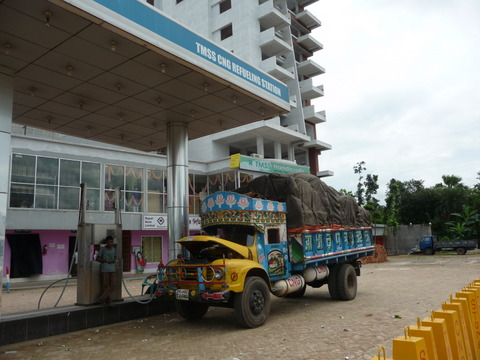BANGLADESH IN OUR FUTURE
Bandarban, Chittagong Hills, Bangladesh. It’s an interesting geopolitical story what I’m doing here, but that will have to wait until next week. This is a very remote region where Bangladesh, India, and Burma come together, and my internet connection is very iffy, so I have to make this quick.
For a backgrounder (up to October 2004) on Bangladesh, see The World’s Most Dangerous Cat Fight. Our future is not to be like here. This is the 8th most populous country on earth – over 140 million – squeezed into Iowa. The ubiquity of humanity is overwhelming – and nowhere more so than on the roads.
You can’t imagine the insanity of it unless you’ve experienced it, exclaiming Sweet JC! in earnest supplication a thousand times with each time you are sure you’ll be in a mangled death-wreck that somehow never happens. Hordes of people walking; rickshaw bikes pedaled by skinny kids carrying people, furniture, sacks of rice, logs, and bamboo poles 50 feet long; motorscooter rickshaws as numerous as ants; motorbikes, cars, huge trucks, and giant buses – all of them frantically trying to pass anything moving slower.
The bus drivers are the craziest. They race each other, constantly beeping their 80 decibel horns, weaving through the maze of barely moving rickshaw bikes at maniacal speeds, barely missing the rickshaws and all other vehicles including each other by inches. This is not occasional – it is constant on the highways, which are always just narrow two lane-ers.
In the cities, villages, and towns, every street and alley is choked and clogged with traffic, from rickshaw bikes to buses, beyond belief. It is dystopian beyond any city or country in the world.
With one exception. And that exception is what should be – needs to be – in our future.
Anyone who has been in an Asian city is familiar with "tuk-tuks" – the motorized rickshaw with a 2-stroke engine that emits the most amazing amount of smoke and soot. The engine is so inefficient 40% of the fuel goes out the tailpipe unburned. This results in horrific air pollution, as there are a billion of these little things in every Asian city. Then there are the trucks and buses, belching gigantic plumes of black exhaust everywhere they go.
But not in Bangladesh. Nobody calls tuk-tuks "tuk-tuks" in this country anymore, or "easy bikes" (another nickname). Today, they are called CNGs – for they no longer run on gasoline anymore. They all run on compressed natural gas – CNG.
The same with buses, trucks, and cars. High pressure CNG stations are all over the country, except in outlying areas, which is why many cars are dual fuel, with two tanks, one for CNG, the other for gasoline or diesel. (An internal combustion engine running either gasoline or diesel can also easily run on natural gas. No engine modifications are needed, just modifying the fuel injection system.)
I took these yesterday at a typical CNG refueling station, as a truck, a car (and a bus behind), and tuk-tuks (sorry, CNGs) were gassing up. There are hundreds of CNG filling stations in this Iowa-size country now.



The price for CNG is far cheaper than gasoline, or petrol as they say here, and you get the same equivalent mileage. It’s hugely popular – and made possible by discovery of large natural gas reserves in northeast Bangladesh in the mid-1990s. Prime Minister Hasima jumped on the opportunity, and instigated a crash program to promote natural gas as a vehicle fuel during her 1996-2000 term of office.
Readers of the linked backgrounder above will be pleased to learn that Hasima was again elected Prime Minister by a landslide in 2008, and has so expanded CNG use that no one uses gasoline/diesel anymore unless they really have to.
TTP has been pushing natural gas as a vehicle fuel since April 2006 in What Bush Can Do To Get Cheaper Gas, followed the next month, May 2006, by The Natural Gas Solution.
Since then, fracking has revolutionized natural gas extraction, with prices plunging and gigantic reserves opened up. So What Romney Can Do To Get Cheaper Gas is replicate what Bangladesh has done to promote dual-fuel vehicles and CNG refueling stations.
The fuel cost of driving would be cut to a couple of pennies a mile. Further, regular engines run much better with natural gas, with less wear and tear (such as on the cylinder compression rings: unburned gasoline at the start washes the lubricant off the top of the cylinder and dries the rings out).
As exciting as the billions we’d all save driving our cars, the national security consequences are equally so. We’d have no need of Saudi oil. Secretary of State Bolton would be free to take whatever measures necessary to force the Saudis to stop spreading their Wahhabi poison. 80% of the mosques in the US are Saudi-sponsored Wahhabi now. Same with Europe.
There are few bigger favors we could do for the world and ourselves than to break the Saudis’ financial ability to foment Wahhabi Radical Islam. And to run our cars on cheap American-produced natural gas at the same time.
That’s what Bangladesh can do for our future.

